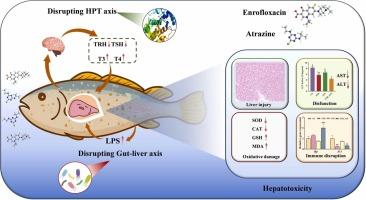恩诺沙星和阿特拉津共同暴露对下丘脑-垂体-甲状腺和肠-肝轴的肝毒性增强
IF 11.3
1区 环境科学与生态学
Q1 ENGINEERING, ENVIRONMENTAL
引用次数: 0
摘要
恩诺沙星(ENR)和阿特拉津(ATZ)是海洋环境中常见的共污染物。虽然ENR的免疫抑制作用和ATZ的内分泌干扰特性已经得到了很好的证实,但这些污染物对肝毒性的综合影响,特别是对下丘脑-垂体-甲状腺(HPT)和肠-肝轴的调节,仍然知之甚少。本研究分别和联合暴露于环境相关浓度的ENR和ATZ下,研究了对虾的肝毒性。观察到肝细胞肿胀、坏死、氧化应激和肝损伤标志物升高,表明肝损伤,共暴露加剧了肝损伤。促甲状腺激素释放激素和促甲状腺激素水平降低,三碘甲状腺原氨酸和甲状腺素水平升高,HPT轴相关基因表达改变,表明在共暴露下HPT轴的破坏增强,这与氧化应激和肝功能障碍密切相关。分子对接证实,ENR和ATZ抑制甲状腺激素与靶蛋白的结合,可能引起肝毒性增强。此外,ATZ显著加剧了ENR引起的肠道细菌紊乱,通过肠-肝轴进一步加重肝毒性。这项研究首次揭示了与ENR和ATZ共暴露相关的风险增加,强调了关注此类共污染物的必要性。本文章由计算机程序翻译,如有差异,请以英文原文为准。

Co-exposure to enrofloxacin and atrazine enhances the hepatotoxicity in Larimichthys crocea by targeting the hypothalamic–pituitary–thyroid and gut–liver axes
Enrofloxacin (ENR) and atrazine (ATZ) are common co-contaminants in marine environments. Although the immunosuppressive effects of ENR and the endocrine-disrupting properties of ATZ are well established, the combined effects of these pollutants on hepatotoxicity, particularly concerning the regulation of the hypothalamic–pituitary–thyroid (HPT) and gut–liver axes, remain poorly understood. In this study, Larimichthys crocea was exposed to ENR and ATZ at environmentally relevant concentrations, individually and in combination, to investigate the hepatotoxicity. Liver cell swelling, necrosis, oxidative stress, and elevated liver injury markers were observed, indicating hepatic damage, with co-exposure exacerbating liver injury. Decreased levels of thyrotropin-releasing hormone and thyroid-stimulating hormone, increased triiodothyronine and thyroxine, and altered expression of HPT axis-related genes demonstrated enhanced disruption of the HPT axis under co-exposure, which was strongly associated with oxidative stress and liver dysfunction. Molecular docking confirmed that ENR and ATZ inhibited thyroid hormone binding to target proteins, likely provoking the enhanced hepatotoxicity. Additionally, ATZ significantly intensified the intestinal bacterial disturbances induced by ENR, further aggravating hepatotoxicity through the gut–liver axis. This study is the first to reveal the increased risk associated with ENR and ATZ co-exposure, highlighting the need for attention to such co-contaminants.
求助全文
通过发布文献求助,成功后即可免费获取论文全文。
去求助
来源期刊

Journal of Hazardous Materials
工程技术-工程:环境
CiteScore
25.40
自引率
5.90%
发文量
3059
审稿时长
58 days
期刊介绍:
The Journal of Hazardous Materials serves as a global platform for promoting cutting-edge research in the field of Environmental Science and Engineering. Our publication features a wide range of articles, including full-length research papers, review articles, and perspectives, with the aim of enhancing our understanding of the dangers and risks associated with various materials concerning public health and the environment. It is important to note that the term "environmental contaminants" refers specifically to substances that pose hazardous effects through contamination, while excluding those that do not have such impacts on the environment or human health. Moreover, we emphasize the distinction between wastes and hazardous materials in order to provide further clarity on the scope of the journal. We have a keen interest in exploring specific compounds and microbial agents that have adverse effects on the environment.
 求助内容:
求助内容: 应助结果提醒方式:
应助结果提醒方式:


